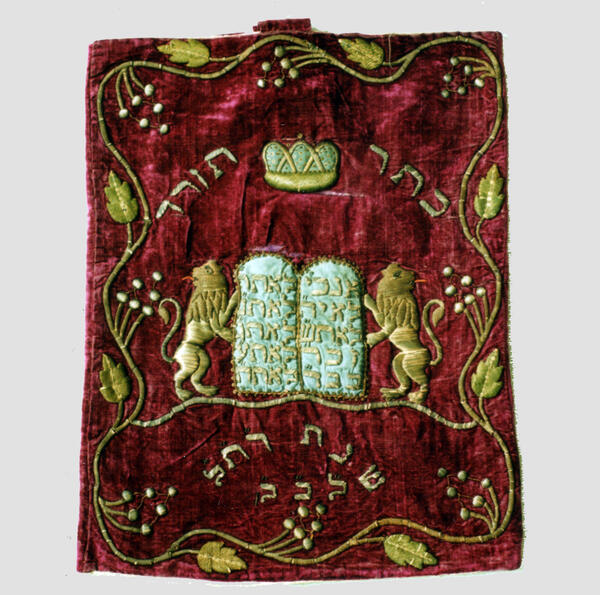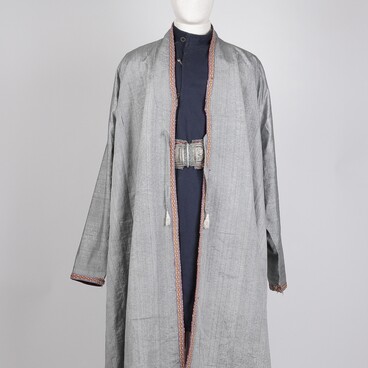The Torah is the core of Judaism, the Hebrew Scriptures. The word “Torah” in Hebrew comes from the verb “leorot”, which means “to instruct”. According to tradition, God gave the Torah to the Jewish people on Mount Sinai more than a thousand years before Christ. For forty days Moses recorded God’s commandments, and for promising to follow them, the people of Israel were granted a blessing.
The text of the Torah on parchment, the Scroll, is intended to be read in the synagogue. As one of the main sacred objects in Judaism, the Torah Scroll is surrounded by ritualistic decorations that emphasize its importance. It is kept in a special cabinet behind an embroidered velvet curtain. It is forbidden to touch it with hands; there is a special silver pointer for this purpose. The scroll itself is tied with an embroidered ribbon and with a cover.
In the Jewish communities of Central and Eastern Europe, the cover of the Scroll was called a mantel or Torah mantle, from the German word mantel, “garment, coat”. The cover for the Torah Scroll is usually decorated with the traditional symbols of Judaism: tablets, crowns, lions, the “tree of life”, and floral patterns.
Embroidery has always been the main decorative element of synagogue textiles. Its style and design were influenced by artistic borrowings from the traditions of different peoples among whom Jews lived. So, the Torah mantle from the collection of the Russian Museum of Ethnography has a vine embroidered along its perimeter, which is a decorative element of the Greco-Roman period of Jewish art.
The scroll was made in the late 19th century in Mogilev, and the vine pattern repeats the winding line of “hops”. This decorative border element was widespread in the folk art of the Eastern Slavs, it was used in the embroidery of rustic towels, tablecloths, and shirts. The same influence on the embroidery of the parokhet inspired the motif of a “vase with a flower” which symbolized the “tree of life” in the peasant art of the East Slavs. On the parokhet, the image of the “vase with a flower” is located above the tablets that represent the Torah. In religious practice, the scroll is wound around two handles, the “tree of life”. The commandments are held and guarded by two lions, symbols of power, strength, and victory.
The text of the Torah on parchment, the Scroll, is intended to be read in the synagogue. As one of the main sacred objects in Judaism, the Torah Scroll is surrounded by ritualistic decorations that emphasize its importance. It is kept in a special cabinet behind an embroidered velvet curtain. It is forbidden to touch it with hands; there is a special silver pointer for this purpose. The scroll itself is tied with an embroidered ribbon and with a cover.
In the Jewish communities of Central and Eastern Europe, the cover of the Scroll was called a mantel or Torah mantle, from the German word mantel, “garment, coat”. The cover for the Torah Scroll is usually decorated with the traditional symbols of Judaism: tablets, crowns, lions, the “tree of life”, and floral patterns.
Embroidery has always been the main decorative element of synagogue textiles. Its style and design were influenced by artistic borrowings from the traditions of different peoples among whom Jews lived. So, the Torah mantle from the collection of the Russian Museum of Ethnography has a vine embroidered along its perimeter, which is a decorative element of the Greco-Roman period of Jewish art.
The scroll was made in the late 19th century in Mogilev, and the vine pattern repeats the winding line of “hops”. This decorative border element was widespread in the folk art of the Eastern Slavs, it was used in the embroidery of rustic towels, tablecloths, and shirts. The same influence on the embroidery of the parokhet inspired the motif of a “vase with a flower” which symbolized the “tree of life” in the peasant art of the East Slavs. On the parokhet, the image of the “vase with a flower” is located above the tablets that represent the Torah. In religious practice, the scroll is wound around two handles, the “tree of life”. The commandments are held and guarded by two lions, symbols of power, strength, and victory.



